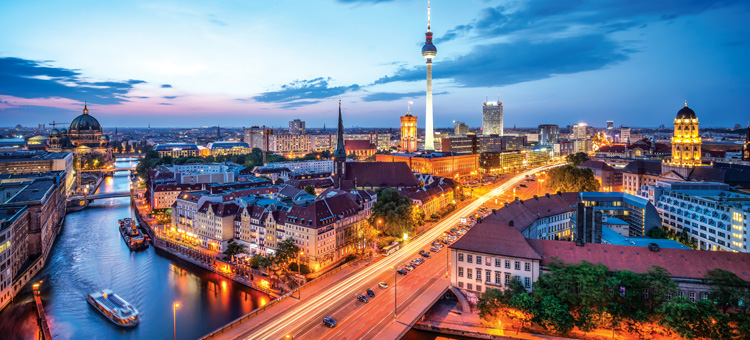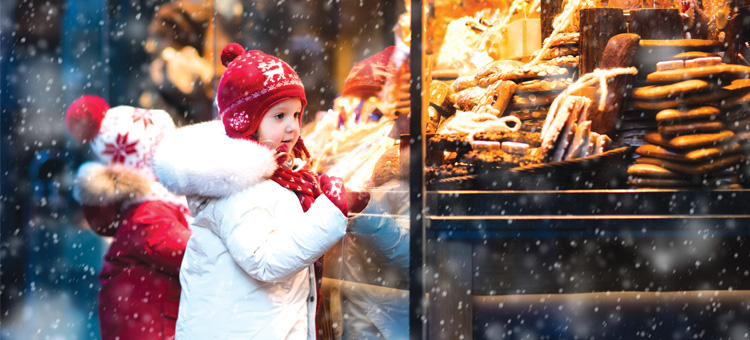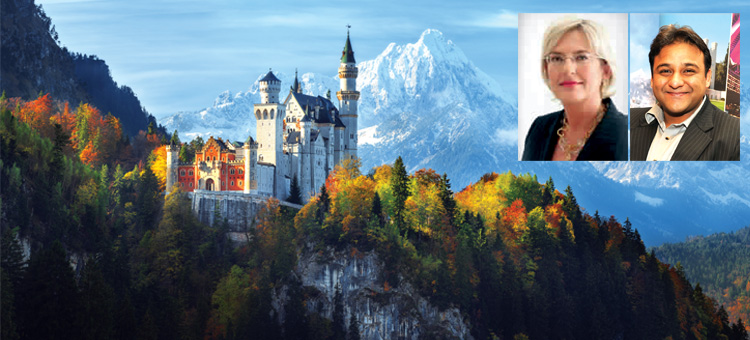Berlin: With over 20,000 castles, 5000 different types of beer, 200 kinds of bread, over 15 wine regions and many holiday routes, Germany has something for everyone. Almost 75 per cent of the country is truly scenic, contrary to popular belief that the landscape may appear very industrial with tall chimneys spitting smoke.
In the 2018 Best Country Report published by News & World Report, Germany was ranked third, scoring highly thanks to its strong economy, worldwide influence and commitment to important global challenges.
According to findings from market research conducted by the German National Tourist Office (GNTO), many Indians do not realise that Germany is the most favoured travel destination in Europe for people from the sub-continent. It is, in fact, a hidden gem, rather shy of marketing itself to the world.
The vibrant cities and beautiful landscapes, coupled with amazing shopping facilities, excellent civic infrastructure and a price-value ratio that is hard to beat in Europe, give Germany a competitive edge and make it a very attractive destination for travel-savvy Indians, who are searching for a diverse and convenient holiday experience.
In 2018, Indian overnights were approximately 9,00,000, roughly representing an 8 per cent growth over 2017. In the period 2008-2017, Indian overnights have exploded by 102.2 per cent. “Our goal is to reach 1 million overnights by 2020 and 2 million overnights by 2030,” said Romit Theophilus, Director – India, GNTO.
About 49 per cent of Indians visit Germany for a holiday; 44 per cent on business and 7 per cent is Visiting Friends and Relatives (VFR) and students. For the Indian clientele, the states of Bavaria with capital Munich, Baden-Württemberg with capital Stuttgart, Hesse (Central Germany) and North Rhine-Westphalia with capital Dusseldorf have traditionally done well. In cities, Munich, Frankfurt, Berlin and Stuttgart top the preferred list followed by Cologne, Heidelberg and Dresden.
Delhi and Mumbai followed by Gujarat are the largest tourism source markets in India for Germany. There are many nonstop flights from Indian cities to Frankfurt and Munich operated by Air India and Lufthansa. Middle East-based carriers also offer excellent connections via their respective hubs.
“In India, our focus has been to strengthen the leisure and incentive segments,” informed Theophilus. “In the leisure segment, we are concentrating our efforts on promoting theme parks, outlet shopping centres, city experiences and routes of Germany. We have so many interesting holiday routes and are currently promoting the Fairy Tale Route, Romantic Road and the Scenic Routes.”
On the incentive front, GNTO wants to showcase Germany for its world-class infrastructure, hotels, activities and convention centres, coupled with value for money or affordable hospitality.
Today, Germany is being seen as a solo destination for leisure travel into Europe, whether it be FIT, DINK (Double Income, No Kids) or family travel and GNTO’s goal has been to combine cities with experiences.
India is one of the first markets where GNTO launched the ‘Germany Specialist’ programme to educate travel trade partners on the destination, its varied products and experiences. According to GNTO, they are targeting 1000 travel agents across the country through the online training programme over the next one year.
Discover 100 Years of Bauhaus
2019 marks the 100th anniversary of the founding of the legendary Bauhaus movement in Weimar, and GNTO is placing this at the centre of its worldwide marketing campaign for 2019.
“The anniversary of the founding of Bauhaus is ideally suited to consolidate Germany’s position as the number 1 cultural destination for Europeans,” explained Petra Hedorfer, Chief Executive Officer, GNTO. “The roots, heritage and international appeal of the Bauhaus movement can be experienced in cities such as Weimar, Dessau, Berlin and many other areas. These are all contributing factors to a very important facet of travel destination Germany’s cultural offering.”
Bauhaus is the most influential design thinking to this date in the field of architecture, art and craft. The famous Bauhaus art school founded by architect Walter Grophius opened in Weimar in 1919, and during its short lifespan moved to Dessau in 1925 and then to Berlin before closing its doors in 1933. The three primary sites are worth a visit to learn more about the movement.
The Dessau building used glass and reinforced concrete – major innovations back then. There are many Bauhaus sites spread across Germany. Besides architecture, the Bauhaus design is famous for removing unnecessary ornamentation and introducing minimalism. This ‘form follows function’ approach paved the way for some iconic products.
For example, the colour form system of basic shapes and primary colours we know today was a contribution of the Bauhaus movement. The Bauhaus was forced to close doors by the Nazi regime but its teachers and students continued to spread the word.
www.bauhaus100.de
Explore Germany’s Scenic Routes at Your Own Pace
Germany’s Scenic Routes are ideal for discovering the country by car, motorbike or bicycle. Choose from over 150 diverse routes, each featuring a different aspect of Germany’s regions.
The tours combine sightseeing with the pleasures of the open road. You decide how fast and how far to travel – and what takes your interest. If you like exploring the countryside, the German Alpine Road could be for you, while history enthusiasts will be fascinated by the German Limes Route. Handcrafted products such as porcelain, clocks and glass all have their own route, and regional products such as wine, cheese and asparagus also provide themes for culinary routes.
Take to the open road and explore Germany at your leisure – just follow the signposts!
Foodie’s Paradise
Food forms an integral part of any traveller’s itinerary. Experiencing the local cuisines helps enhance the flavour of any holiday and makes for everlasting impressions. With 1300 breweries, 1500 types of sausage, 292 Michelin-starred restaurants and 3000 to 5000 Christmas markets, Germany is sure to satiate any traveller’s appetite.
From ‘Pannfisch’ fried fish in the north to green sauce and ‘Bratwurst’ sausages in Central Germany to dumplings, ‘Maultaschen’ pasta pockets and ‘Eisbein’ ham hock in the South, German cuisine is as diverse as the country’s varied landscape.
German Tourism highlighted the culinary side of Germany in 2018, with a global marketing campaign ‘Culinary Germany’.
Vegetarian Fare
I would say not just survive but vegetarians can thrive in Germany.
There are quite a few vegetarian options available in all the restaurants/cafes that you can think of.
In the bakeries (which are abundant in Germany) one is spoilt for choice as there are varieties of bread to choose from (sweet or not so sweet, based on your choice) – rolls, mini breads, brezels, croissants, sandwiches etc.
Turkish shops have Falafel, Döner (ask specifically for vegetarisch), Spinach and Feta cheese Pide (flat bread). They often joke that a döner might be the next national food of Germany soon.
If you are a fan of Italian – there is no shortage of Italian restaurants with many options to choose from (pizzas, pastas, salads and so on).
Asian/Thai restaurants offer lots of vegetarian options (rice/noodles with various choices of curry) not to mention full menus for vegetarians, including five to six types of vegetarian sushi as well.
There are Asian/Indian shops which sell all varieties of pulses/green chillies/coriander/imported vegetables that you might otherwise not find in major stores.
Some other commonly available vegetarian dishes are Potato Balls, Potato Salad, Potato fritters, Käsespätzle, vegetable meatballs, vegetable bagels and so on.
Indian Restaurants
Restaurant Ganesha in Regensburg, Bavaria: The staff is very friendly; the ambience excellent with unique decoration reflecting the true culture of India. If you don’t reserve a table during the weekend, then perhaps you have to wait for an hour to get one. Specialty – vindaloos and tandoori chicken.
eatDOORI in Frankfurt: The modern ambience combined with a European vibe is so different than the traditional Indian restaurants. It is located near the main station and advisable to pre-book a table as it is always packed. Must try – ginger lime prawns, sweet potato puffs and mango yogurt.
Taj Mahal Indisches Restaurant in Stuttgart: Reasonably priced and sporting authentic ambience with enough privacy to have your own little dinner party. The food here is delicious! Must try – Paneer pakodas, Bhindi masala and Mango lassi.
Indian Village in Munich: A favourite of not just Indians but Germans living in Munich too! They have delicious lunch buffet with a wide range of curry, starters and some sweets. Must try – lamb karahi, beef curry and butter chicken (don’t worry, veg and vegan options are available too!)
Ashoka in Hamburg: Cosy, atmospheric, good food, Ashoka is a hidden gem. The dishes and sauces are homemade using fresh ingredients. One of the city’s favourites, but prices are on the higher side. Must try – Gajar Ka Halwa and a separate menu for vegans with lassi and ice cream especially for them.
Haveli in Berlin: Run by a friendly Indian family, the ‘mom’ greets you and the ‘daughter’ shows you to the table. The menu takes you around most of India. Must have – thali with brinjal fries as starters, Peshwari naan, lamb vindaloo, and chicken and prawns cooked with coconut.
Sometimes Fairy Tales Come True
Welcome to the home of fairies and princes, Sleeping Beauty, Snow White, Little Red Riding Hood and Cinderella. Let the 600 km German Fairy Tale Route transport you to the magical world of the Brothers Grimm, from their birthplace in Hanau to Bremen, the home of the famous four-legged town musicians (Tiercombo).
Many fairy stories begin with “Once upon a time…” Now you can create your own fairytale adventure as you follow in the footsteps of these two master storytellers. You might want to borrow some seven league boots – but if a nasty witch has stolen them, a bicycle or a car will do instead. The German Fairy Tale Route offers culture and history, enchanting medieval towns, bewitched castles, fairy tale palaces, grottos and museums.
A Route With a Fairy Tale of Its Own
Lose yourself in a realm of fairy tales, sagas, myths and legends, where the festivities never stop: open-air plays, puppet theatres, fairy tale festivals, barn festivals, themed meals and medieval Tafeleyen feasts – and there’s even the chance to bump into some of your favourite fairy tale characters. Fairy tales can be found everywhere, even where you least expect them. On the German Fairy Tale Route, the everyday is an entire world away.
A Meeting Of Fairy Tale Fans
The route is a place where childhood dreams spring to life, where the seven dwarfs and their seven mountains living side by side with daring princes and fairies will cast a spell on you (unless the Pied Piper whisks you away first!). Bump into Little Red Riding Hood, who still hasn’t got to her granny. Or Rapunzel, Hansel and Gretel, and Mother Hulda (still shaking out her featherbeds). Live the dream in Sababurg Castle, where Sleeping Beauty’s prince woke her from her enchanted sleep. And experience what it feels like to be Hans in Luck.
When Imagination is in Free Flight
Art and culture, eight nature parks, enchanting highlands and riversides line the route, while images of half-timbered villages and romantic cities flutter past one after the other like the pages of a storybook. Delve into a countryside scattered with flowers, stride through deep forests, put your finger on the pulse of vibrant cities and enjoy the hospitality that lies round every twist and turn of the German Fairy Tale Route.
Romantic Road – The Name is Like a Promise
The Romantic Road whisks you away on a journey of approximately 400 km from Würzburg to Füssen in the Allgäu. Anyone visiting this route is greatly rewarded with treasures such as magnificent stately homes, palaces of courtly splendour and romantic medieval timber-framed houses following in swift succession. This route also lives up to its name when travelled by bicycle or on foot.
The Romantic Road has been the highlight amongst Germany’s Scenic Routes for over 60 years and is still a firm favourite attracting visitors from all over the world. Nature, culture and hospitality are the three hallmarks of the Romantic Road. It offers excitement for art lovers, festival goers, history buffs, sports devotees and everyone who likes a celebration.
Romance; the scent of grapes in the air and the draw of the Alps: the charm of this route knows no bounds. It takes in the varied landscapes of the Main river, the Franconian wine region and the Alpine peaks and crosses the tranquil Tauber Valley between Würzburg and Füssen, the geological treasure trove of Nördlinger Ries, the picturesque Lechfeld and the dream-like Pfaffenwinkel region at the foot of the Bavarian Alps before arriving at King Ludwig’s spellbinding castles. This region is surrounded by four lakes and lies at the bottom of the Ammergau Alps. A location steeped in romance.
The very name Romantic Road expresses how visitors, from Germany and abroad, feel when they first feast their eyes on this spectacular backdrop of riches, western history, art and culture: fascination and a sense of being taken back in time. Also linked with the route are great names such as Balthasar Neumann, the architect; Tilman Riemenschneider, the woodcarver, and Carl Spitzweg, the painter.
A Festival Road Too
The Romantic Road is also Germany’s festival road: from May until well into the autumn, it fizzes with historical festivals offering fresh air, entertainment, delectable food and tangy beer. It’s enough to make you sigh; once you’ve left, a simple reminder will be all it takes to bring a smile back to your face.







